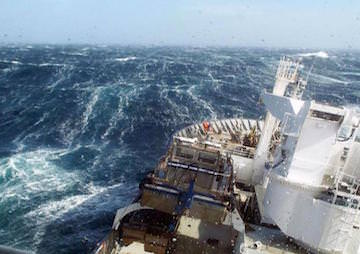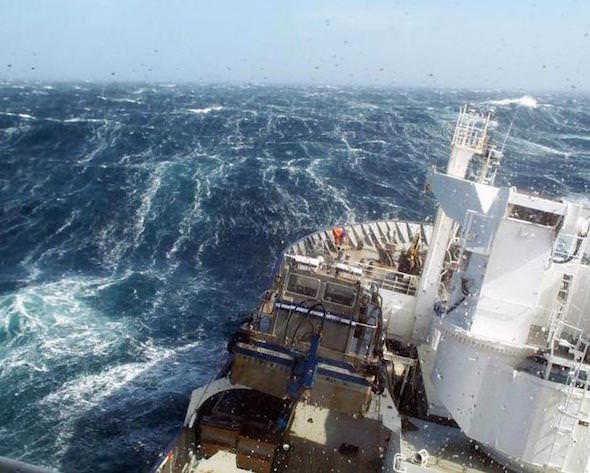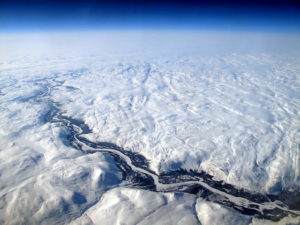Southern Ocean Starts to Soak Up Carbon Again
Scientists report that the great oceanic “lung” is again breathing in vast amounts of carbon dioxide from the atmosphere, but can’t say why or whether it will last.
By Tim Radford, Climate News Network

A research vessel plows through the waves of the Southern Ocean, also known as the Antarctic Ocean, to measure levels of dissolved carbon dioxide. (Nicolas Metzl, LOCEAN/IPSL Laboratory)
This Creative Commons-licensed piece first appeared at Climate News Network.
LONDON — The high seas have begun to respond again to the changes in the atmosphere, with two new studies confirming that the Southern Ocean is absorbing more atmospheric carbon.
Levels of carbon dioxide in the atmosphere have been steadily increasing as humans burn ever more fossil fuels, but climate scientists will probably hesitate before exhaling sighs of relief over the latest findings.
Rising CO2 in the atmosphere means global warming, which means climate change, melting ice caps, rising sea levels — and even more global warming and climate change.
So the discovery that one great stretch of hostile ocean is soaking up more of the stuff sounds like very good news. However, the celebrations are likely to be cautious, as there is no guarantee that the process is permanent.
Human activities
Scientists led by Peter Landschützer and Nicolas Gruber, from the Swiss Federal Institute of Technology (ETH Zurich), report in Science journal that there had been fears that the ocean had become saturated and could absorb no more carbon from the atmosphere. No increase had been measured since the late 1980s.
“The Southern Ocean behaves like a giant lung, breathing in and absorbing vast amounts of carbon dioxide from the atmosphere, and releasing it later in the year,” says one of the team, Dorothee Bakker, research officer in the School of Environmental Sciences at the University of East Anglia, UK.
“The seas around Antarctica absorb significantly more CO2 than they release. And, importantly, they remove a large part of the CO2 that is put into the atmosphere by human activities such as burning fossil fuels.
“They basically help to slow down the growth of this greenhouse gas in the atmosphere and lessen the rate of climate change.”
“The seas around Antarctica remove a large part of the CO2 that is put into the atmosphere by human activities such as burning fossil fuels.”
However, there is no clear reason why the Southern Ocean should have started to gulp down atmospheric carbon once more. A change in wind and circulation patterns is the best explanation. But, if so, the “reinvigoration” may not be permanent.
Permanent or not, it is certainly real. Research proceeds by replication, and a second study reports in Geophysical Research Letters that researchers focused on millions of systematic measurements made over the last 13 years in just one segment of the Southern Ocean — the tempestuous Drake Passage between the tip of South America and the tip of the Antarctic Peninsula.
The Southern Ocean matters because it is — or was thought to be — a voracious consumer of atmospheric carbon.
Wind patterns
“Although it comprises only 26% of the total ocean area, the Southern Ocean has absorbed nearly 40% of all the anthropogenic carbon dioxide taken up by the global oceans up to the present,” says one of the authors, David Munro, an atmospheric and oceanic sciences researcher at the Institute of Arctic and Alpine Research at the University of Colorado-Boulder, in the US.
It remains uncertain why this should be happening, but wind patterns, temperature and ocean upwelling are almost certainly factors.
“It’s likely that winter mixing with deep waters that have not had contact with the atmosphere for several hundred years plays an important role,” Dr Munro says.
There is no guarantee that the ocean will go on gulping down the carbon dioxide pumped out from power stations and car exhausts. The research will continue.
“Our statistical model is not able to predict the future development, so it is critical that we continue measuring the surface ocean CO2 concentrations in the Southern Ocean,” Dr Landschützer says.
Your support matters…Independent journalism is under threat and overshadowed by heavily funded mainstream media.
You can help level the playing field. Become a member.
Your tax-deductible contribution keeps us digging beneath the headlines to give you thought-provoking, investigative reporting and analysis that unearths what's really happening- without compromise.
Give today to support our courageous, independent journalists.






You need to be a supporter to comment.
There are currently no responses to this article.
Be the first to respond.